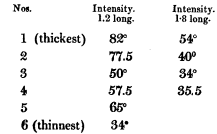Article contents
II. An Account of some Experiments on the Electricity of Tourmaline, and other Minerals, when exposed to Heat
Published online by Cambridge University Press: 17 January 2013
Extract
Although the phenomena of the Pyro-Electricity of Minerals, as it has been termed, and those of the Tourmaline in particular, have, after a long period of neglect, been recently studied by more than one philosopher of eminence, there are a sufficient number of undetermined or debatable points, even at the threshold of the inquiry, to yield facts of novelty and interest to those who will take the trouble to look for them.
Having during the past summer been much engaged in studying the relations of bodies to heat and electricity, I was induced, by having in my possession a considerable number of long tourmalines, to repeat and endeavour to verify some recently published experiments with this mineral. These inquiries brought out several new facts; and, with the hope of adding something to our knowledge in this curious field, I have taken this opportunity of communicating to the Society the results of some very recent experiments.
- Type
- Research Article
- Information
- Earth and Environmental Science Transactions of The Royal Society of Edinburgh , Volume 13 , Issue 1 , 1835 , pp. 25 - 38
- Copyright
- Copyright © Royal Society of Edinburgh 1835
References
page 25 note * The publication of this paper was delayed partly under the idea of prosecuting the experiments of which it contains an account; but the author having engaged in some other researches, which appear to him of more immediate importance, he merely prints this communication in its original form.—April 1834.
page 26 note * P. 478.
page 26 note † Edinburgh Journal of Science, i. 211.
page 28 note * It is surprising that Coulomb's instrument has not been more employed in this inquiry. Becquerel seems only to have used it once, and Dr Brewster had recourse to the laborious and unsatisfactory method of causing pyro-electric crystals to lift fragments of the Arundo Phragmites, which can give no comparative results.
page 31 note * Ann. de Chimie.
page 31 note † P. 477.
page 32 note * The best pair of series gave,

page 33 note *

page 35 note * It is No. 3. of the Series, at the foot of p. 32.
page 37 note * The disk during this time was of course slowly parting with its charge.
- 4
- Cited by




